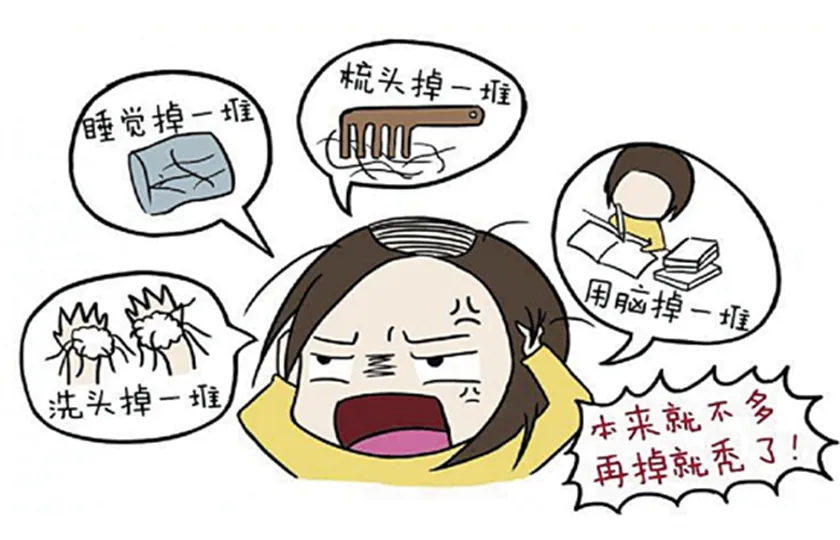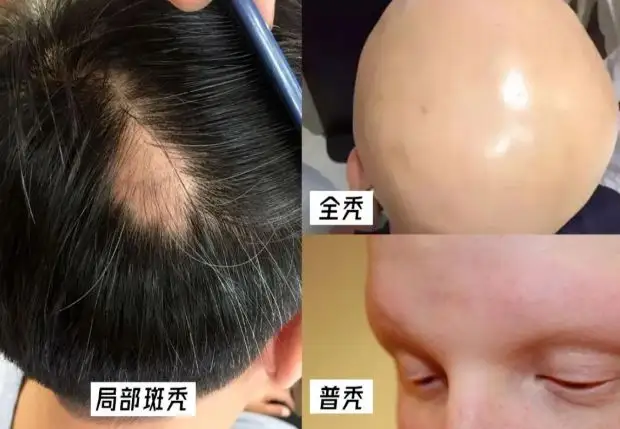"Bald" as it comes! How to save you, my hair
On the road of life, some people walk away, and some hair looks at less
Suddenly look back, he may be on the pillow, between the combs, in the bathroom...

Hair is often referred to as ";three thousand troubled strands," but losing them can also cause more troubles
Nowadays, more and more people are suffering from hair loss, and they are getting younger and younger. What can we do to save our hair?

First, we need to determine whether hair loss is a normal physiological phenomenon or pathological hair loss.
Under normal circumstances, the growth cycle of hair can be divided into growth period, regression period, resting period, respectively, 3 years, 3 weeks and 3 months. A normal person loses 60-100 hairs a day and regrows the same amount. If you suddenly find that hair loss increases over a period of time, and then gradually recovers, it is likely to be just physiological hair loss, do not worry too much ~
 However, if it is found that more than 100 hair is lost every day, and the hairline is constantly moving back, the hair is thinning, and the hair seam is widening, this time it is necessary to cause alarm!
However, if it is found that more than 100 hair is lost every day, and the hairline is constantly moving back, the hair is thinning, and the hair seam is widening, this time it is necessary to cause alarm!
There are many types of hair loss, such as seborrheic alopecia, alopecia areata, and hair loss caused by endocrine disorders. In order to protect the top of our heads, we need to understand the cause of the disease, the right treatment.
 1. Alopecia seborrheica
1. Alopecia seborrheica
Alopecia seborrheica, also called androgenic alopecia, is the most common type of hair loss, accounting for more than 90% of all hair loss. This type of hair loss occurs more in men, and there are different clinical manifestations between men and women. It is a non-cicatricial alopecia that occurs during and after puberty and is characterized by hair follicle minimization and progressive hair loss. The disease has a genetic predisposition, with 29.7% of male patients and 19.2% of female patients having a family history of androgenic alopecia.
 Androgenic alopecia is a process of progressive aggravation until baldness, so early diagnosis and long-term treatment are very important. In general, the earlier the treatment, the better the effect, when you have the above symptoms must seek medical attention as soon as possible! At present, the commonly used treatment methods are:
Androgenic alopecia is a process of progressive aggravation until baldness, so early diagnosis and long-term treatment are very important. In general, the earlier the treatment, the better the effect, when you have the above symptoms must seek medical attention as soon as possible! At present, the commonly used treatment methods are:
? Topical use: 5% minoxidil for men and 2% minoxidil for women;
? Systemic medication: male oral finasteride, female oral spironolactone or cyproterone;
? Hair transplantation and low energy laser, microneedle therapy treatment and so on
Combination therapy is usually recommended for better results, and the specific program needs to be adjusted according to the individual situation of the patient.
Two, alopecia areata
Alopecia areata, the common people call its ghost shaved head, that is, the sudden circular hair loss of the head, does not hurt or itch. Alopecia areata is a non-cicatricial hair loss disorder dominated by psychogenic factors and associated with autoimmunity that can continue to develop fusion. When all hair is removed, it is called total baldness, and even further, eyebrows, armpit hair, and pubic hair are lost, which is called general baldness.
 At present, the etiology is not completely clear, may be related to genetic, mental and emotional stress, endocrine disorders, autoimmune and other factors. In the treatment, we generally try to find the possible causes and predisposing factors and remove them:
At present, the etiology is not completely clear, may be related to genetic, mental and emotional stress, endocrine disorders, autoimmune and other factors. In the treatment, we generally try to find the possible causes and predisposing factors and remove them:
? Keep a happy mood: firm confidence in healing, some patients can even heal themselves; For patients with severe insomnia, anxiety, depression and other symptoms, sedatives and neuromodulators can be taken as appropriate;
? Topical drug treatment: generally 2%-5% minoxidil solution, 10% tincture of capsicum can be used to promote blood circulation;
? Local injection of glucocorticoids: suitable for hair loss in a small range, can be directly injected into the hair loss area, can also be injected into its periphery, in order to control the continued expansion of the hair loss range;
? Systemic treatment: For patients with rapid and extensive alopecia and general alopecia, oral hormones or immunosuppressants such as methotrexate and baritinib can be taken;
? Pay attention to vitamin supplementation (cystine, vitamin B6), appropriately increase high-protein, high-trace element diet;
? Physical therapy: microneedle therapy, liquid nitrogen freezing, He-Ne laser is also a good auxiliary treatment means;
? Of course, there are tonifying qi and blood, protecting the liver, tonifying the kidney of the Chinese patent medicine also has a certain therapeutic effect
Three, endocrine disorder alopecia
Endocrine disorder alopecia is due to the abnormal function of endocrine glands and hormone imbalance in the body caused by hair loss called endocrine disorder alopecia. Postpartum, menopause, oral contraceptives and other conditions, in a certain period of time will cause estrogen deficiency and hair loss; Hypothyroidism or hyperthyroidism, hypopituitarism, hypoparathyroidism, adrenal tumors, and advanced acromegaly can all lead to hair loss. Treatment of endocrine disorder alopecia, first of all to restore the hormone level to normal, it is best to go to the hospital to check, lack of hormones need to add how much medicine, only the right medicine, secretion disorder alopecia can be cured faster.
 In addition to these conditions, some autoimmune diseases, infection wasting diseases, major surgery, trauma, etc., can also cause hair loss.
In addition to these conditions, some autoimmune diseases, infection wasting diseases, major surgery, trauma, etc., can also cause hair loss.
There are also some medications that may cause hair loss: such as taking lipid-lowering drugs, blood pressure drugs, antidepressants, etc.
Therefore, when there is hair loss trouble, please seek medical attention in time and seek scientific help from the doctor. May we all have a black and dense hair
Author:
Professor Xie Jun Li Lu Zhongnan Hospital of Hubei Province
(The opinions expressed are solely those of the author. Some pictures in this article are from the Internet, if there is infringement, please contact to delete)

